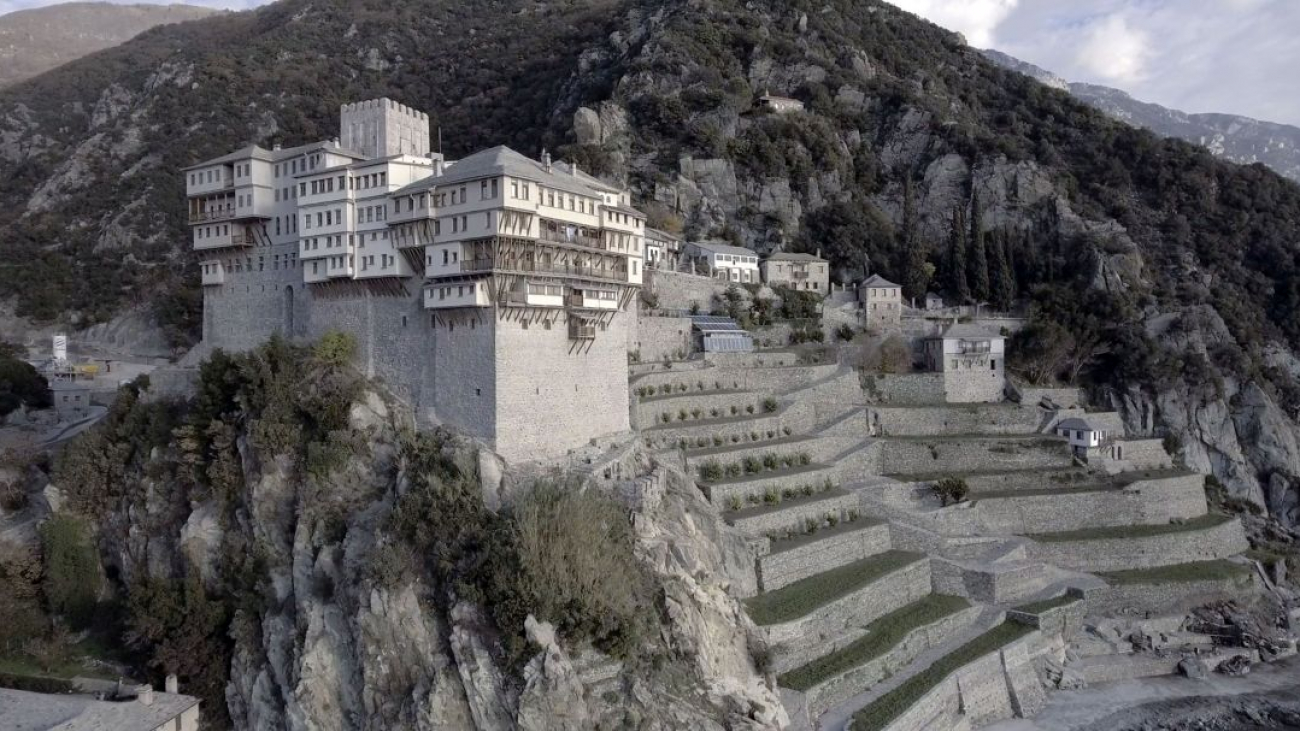The Founding
The founding of the Dionysios Monastery is dated to the second half of the 14th century and is attributed to the Holy Dionysios, who came from Korisso of Kastoria. At first Dionysios was a member of the brotherhood at the Filotheos Monastery where his older brother Theodosios was Abbot, but Dionysios left there and went to the south side of the peninsula, where he lived as an ascetic in the foothills of Little Athos. Later, because of the wind and the cold, he and his students moved to a location lower down on the mountain, on an area with a flat surface – the so-called ‘old stremma’ -- where they built huts and a church dedicated to St John the Baptist (the Holy Precursor), and planted a vineyard. Since the number of students constantly increased, Dionysios built more huts next to the torrent Drouvanisti, and a second church, which was dedicated to the Virgin Mary. Thus, a complete settlement of ascetic dwellings under his spiritual guidance was created, and Dionysios was referred to as the ‘Abbot of the Huts’ in a document of the Protos of Mt Athos.
The rocky and isolated location was ideal for the practice of asceticism. The brotherhood, however, moved to the cliff where the Monastery is located today, not only for reasons of survival, but also to fulfil the vision which Dionysios had twice had: A column of light upon the cliff above the sea, accompanied by the miraculous form of the Holy Precursor, their protector.
With the intervention of his brother Theodosios – who by that time had become the Metropolite of Trebizond (Τραπεζούντος) – Dionysios successfully obtained a chrysobull from the Emperor Alexios III Komninos in 1375. This was the ‘ownership’ chrysobull, which officially marked the founding of the Monastery and assured its institutional existence, its physical infrastructure and its economic survival, a document which is still safeguarded in the Monastery today. At the beginning of the document, there is a small depiction of the Emperor Alexios III and his wife Theodora holding the chrysobull together, looked down upon and blessed by St John the Baptist. Thus, Dionysios built the Monastery, with a high level of support, but also with a great deal of work and sacrifices, including facing the problems caused by repeated pirate raids as well as from natural disasters.
In the chrysobull, the Emperor promised to build a church and cells, an aqueduct for bringing water to the site, and to construct the entire monastery, simply asking in return that he, his family, and his descendants would always and without interruption be remembered in all of the liturgies, a wish which is carefully fulfilled until today. He also asked that the monastery be named ‘the Great Komninos’, and to warmly receive citizens of Trebizond as either visitors or as monks.
To cover the construction costs, Alexios donated 100 somia (units of weight, which later became currency), an amount which in 1340 was equivalent to 140 aspra or silver coins), 50 of which were given immediately to Dionysios, and the remainder to be given within three years. An annual contribution by the Emperor and his heirs of 1,000 komninata was also pledged, so that the construction works would proceed without interruption.
The rocky and isolated location was ideal for the practice of asceticism. The brotherhood, however, moved to the cliff where the Monastery is located today, not only for reasons of survival, but also to fulfil the vision which Dionysios had twice had: A column of light upon the cliff above the sea, accompanied by the miraculous form of the Holy Precursor, their protector.
With the intervention of his brother Theodosios – who by that time had become the Metropolite of Trebizond (Τραπεζούντος) – Dionysios successfully obtained a chrysobull from the Emperor Alexios III Komninos in 1375. This was the ‘ownership’ chrysobull, which officially marked the founding of the Monastery and assured its institutional existence, its physical infrastructure and its economic survival, a document which is still safeguarded in the Monastery today. At the beginning of the document, there is a small depiction of the Emperor Alexios III and his wife Theodora holding the chrysobull together, looked down upon and blessed by St John the Baptist. Thus, Dionysios built the Monastery, with a high level of support, but also with a great deal of work and sacrifices, including facing the problems caused by repeated pirate raids as well as from natural disasters.
In the chrysobull, the Emperor promised to build a church and cells, an aqueduct for bringing water to the site, and to construct the entire monastery, simply asking in return that he, his family, and his descendants would always and without interruption be remembered in all of the liturgies, a wish which is carefully fulfilled until today. He also asked that the monastery be named ‘the Great Komninos’, and to warmly receive citizens of Trebizond as either visitors or as monks.
To cover the construction costs, Alexios donated 100 somia (units of weight, which later became currency), an amount which in 1340 was equivalent to 140 aspra or silver coins), 50 of which were given immediately to Dionysios, and the remainder to be given within three years. An annual contribution by the Emperor and his heirs of 1,000 komninata was also pledged, so that the construction works would proceed without interruption.

